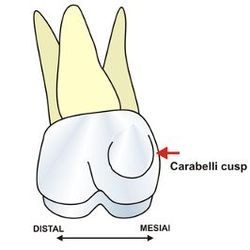Definition and Characteristics of the Cusp of Carabelli
- The cusp of Carabelli is a small additional cusp at the mesiopalatal line angle of maxillary first molars.
- It is usually found on secondary maxillary first molars and rarely seen on primary maxillary second molars or other molars.
- The cusp of Carabelli may vary in size and can even rival the main cusps.
- It can appear as ridges, pits, or furrows.
- Georg Carabelli, a Hungarian dentist, first described this cusp in 1842.
Heritability and Genetic Factors
- The cusp of Carabelli is a heritable trait.
- Homozygosity of a gene can result in a pronounced tubercle, while the heterozygote may show slight grooves, pits, or bulges.
- Multiple genes influence the development of this trait.
- Kraus (1951) proposed the genetic basis of the cusp of Carabelli.
- Studies indicate that the trait is found in different frequencies among different populations.
Composition and Structure
- The cusp of Carabelli is referred to as a tubercle rather than a cusp.
- It may be composed only of enamel and may not contain dentin.
- It does not have a root underneath.
- In some cases, the cusp may have a pulp horn.
- If the cusp is large, it will typically be formed of dentin and enamel.
Evolutionary Significance
- The Carabelli cusp is present in archaic human species, such as Neanderthals.
- It is believed to serve the purpose of reducing stress on the teeth by increasing their surface area.
- The functional role of the Carabelli trait in early and late hominins has been studied.
- Its presence in different populations suggests an evolutionary history.
- Further research is needed to fully understand its significance in human evolution.
Related Dental Anomalies and Terms
- Dens evaginatus is a dental anomaly similar to the cusp of Carabelli.
- Talon cusp is another dental anomaly that can occur on maxillary incisors.
- Tubercle is a general term used to describe small, abnormal protrusions on teeth.
- Understanding the cusp of Carabelli can contribute to the field of forensic dentistry.
- Dental anthropology provides insights into the study of dental anomalies like the cusp of Carabelli.
The cusp of Carabelli, or Carabelli's tubercle, or tuberculum anomale of Georg Carabelli is a small additional cusp at the mesiopalatal line angle of maxillary first molars. This extra cusp is usually found on the secondary maxillary first molars and is rarely seen on primary maxillary second molars even less likely on other molars. This cusp is entirely absent in some individuals and present in others in a variety of forms. In some cases, the cusp of Carabelli may rival the main cusps in size. Other related forms include ridges, pits, or furrows. This additional cusp was first described in 1842 by the Hungarian Georg Carabelli (Carabelli György), the court dentist of the Austrian Emperor Franz.
The cusp of Carabelli is a heritable feature. Kraus (1951) proposed that homozygosity of a gene is responsible for a pronounced tubercle, whereas the heterozygote shows slight grooves, pits, tubercles or bulge. Later studies showed that the development of this trait is affected by multiple genes. According to Stimson and Mertz, this trait is found in 50% of European Americans, 34% of African Americans 5-20% of Native Americans.
Although it is sometimes referred to in textbooks as the Cusp of Carabelli, it is actually a tubercle, as it is may be made only of enamel, and may not contain dentin but never has a root underneath. It is unlikely, but entirely possible for the cusp to have a pulp horn. If the cusp is large, approaching the size of a regular cusp, then it will typically be formed of dentin and enamel.
The Carabelli cusp is present in several archaic human species such as Neanderthals, and it is believed that it serves to reduce stress on the teeth by increasing their surface area.

